5+ Sample Trademark Assignment Agreement
-
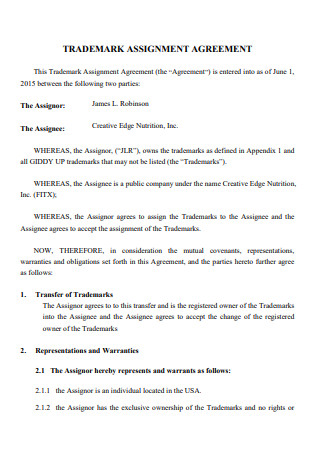
Trademark Assignment Agreement Template
download now -
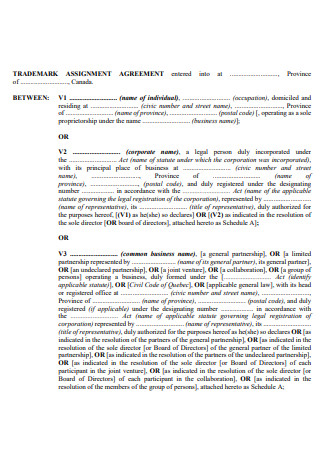
Sample Trademark Assignment Agreement
download now -
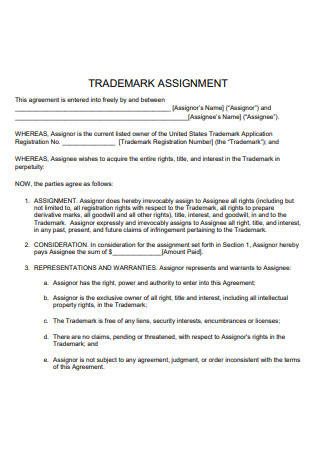
Trademark Assignment Agreement Example
download now -
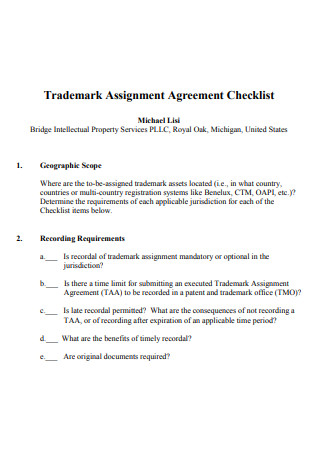
Trademark Assignment Agreement Checklist
download now -
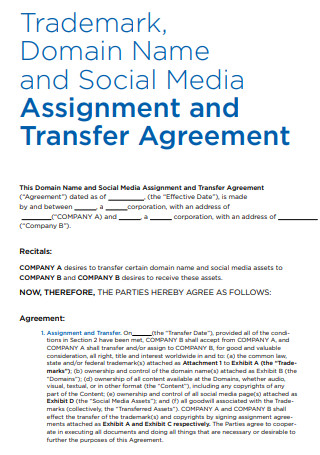
Trademark Assignment and Transfer Agreement
download now -
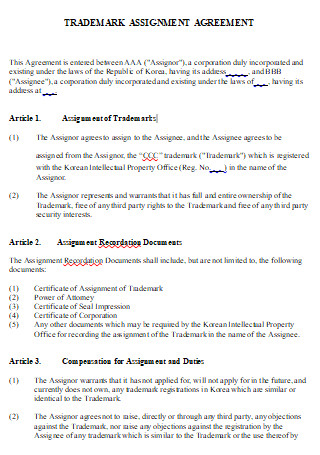
Trademark Assignment Agreement in DOC
download now
FREE Trademark Assignment Agreement s to Download
5+ Sample Trademark Assignment Agreement
What Is a Trademark Assignment Agreement?
What Are The Various Ways of Assigning The Trademark?
Benefits of Trademark Assignment Agreement
Elements of Trademark Assignment Agreement
How to Create Trademark Assignment
FAQs
How Can a Person Know If Something Is Trademarked?
Can a Person Buy a Trademark From Someone?
Can a Person Sue Someone For Using The Registered Trademark?
What Is a Trademark Assignment Agreement?
A trademark assignment is the transfer of an owner’s title, rights, and interest, as well as services in a trademark. It is an agreement where the transferring party transfers and conveys all property marks to the receiving part. Trademark license and trademark assignment are different from each other in terms of the permissions granted. The former is only granted permission to use a mark, however, the latter implies the transfer of legal rights of ownership, and it is associated with Technology Transfer Agreements (TTA). The transferring party is allowed to transfer registered words, phrases, symbols, and signs to another owner or the receiving part. In simpler terms, it is the passing and conveying of full or partial rights of the transferring party to the receiving party depending on the terms and conditions of the trademark. Registered and unregistered trademarks are transmitted and passed from one person to another in which they can be transferred with or without any goodwill of the business concerned. The transferring party is allowed to transfer the trademark to whoever he or she entrusts it for as long as they both agree to one another’s terms and conditions through the agreement. In addition to that, the current owner or transferring party is known as “the Assignor”, and the future or next owner and the receiving party are known as “the as Assignee”.
What Are The Various Ways of Assigning The Trademark?
An individual is allowed and can assign the trademark through a trademark assignment agreement. There are a lot of ways that a trademark assignment can be assigned. Listed below are the following ways that a trademark can be assigned to the next owner or the assignee:
1. Complete Assignment
A complete assignment is the transfer of all rights together with rights to royalties, rights to further transfer from one individual to the other. It shows the complete transfer and passing of the trademark from the transferring party to the receiving party.
2. Partial Assignment
From the word itself “partial”, meaning, it only transfers a certain product or service of the trademark. Furthermore, it also conveys the transfer of ownership of a restricted product or service from the transferring party to the receiving party.
3. Assignment With Goodwill
Transferring of services and products may be done through a registered and unregistered trademark bearing in mind whether or not they have assigned goodwill. Assignment with goodwill refers to the transfer of trademark done along with all the rights and values associated with the trademark from one person to the other. In simpler terms, the transfer is allowed together with all the rights that the first owner has gained to be passed on to the next owner.
4. Assignment Without Goodwill
Following the assignment with goodwill, we have the assignment without goodwill. The trademark assignment without goodwill clearly states that the transfer of trademark by the owner in such a manner can only be utilized for any other purpose aside and except for the original. In other words, an exception of the original trademark is being taken into account.
Benefits of Trademark Assignment Agreement
Marketing a trademark can be somewhat frustrating to a company or even to the assignor. Yet, having a trademark in business means that the intellectual property is legal. Here are a few benefits that a trademark assignment can withhold:
1. Monetization of Brand
One thing that a trademark assignment can give benefit to the business is that it allows you to monetize the value of your trademark. You can even enjoy the fruit of your labor as well as all the investments you have made and done for creating the brand.
2. Easy Brand Building
It is of benefit to the assignee that he or she does not need to work to build a brand of their own.
3. Maintenance of IPR
Another benefit of trademark assignment is that it helps in maintaining the intellectual property in terms of registration of the same.
4. Owner Gets The Value of The Trademark
Making and building your own brand requires a lot of time, effort, and even investments but a benefit of this is that it helps the owner of the trademark in getting the cash value of the trademark.
5. Acts as a Valid Proof
Trademark assignments can act as valid proof of any legal affirmations. The legal rights of both parties are well protected by the agreement.
6. Expansion of Business
Having this all in mind, the trademark assignment helps in expanding your business ventures in similar markets in the industry.
7. Owner Enjoys Various Benefits
It takes a lot of effort, time, and investment for the owner of the trademark to have his or her products have a trademark yet another benefit of this is that the owner can enjoy different benefits that deal with an existing trademark.
Elements of Trademark Assignment Agreement
In creating a trademark assignment agreement there are elements that have been taken into account. Without these elements, it would be difficult for people to understand a trademark assignment agreement. Although it is somewhat the same with other agreements, there are still some parts that should be discussed and comprehended. In the table below, the elements of a trademark assignment agreement are stated and explained:
How to Create Trademark Assignment
1. Make an Application
The first thing that you need to do in order to create a trademark assignment is to apply for it. It can be done by either the assignee or the assignor or it can be both of them. After that, whoever applied for the trademark assignment must specify all the details in documents that will be transferred.
2. Submission of Forms and Documents
After making an application, submit all related forms and documents to the registrar.
3. Apply To The Registrar
Once it has been submitted, file a trademark with the registrar within three months of acquisition of proprietorship following the same process. Take note that the applicant is notified regarding the assignments. Should there be any concerns or problems, the applicant should call and provide proof of the errors/ doubts.
4. Direction From The Registrar
When the applied trademark assignment is with goodwill, the direction from the Registrar is mandatory before the expiry of 3 months. But, do not worry it can be extended as per request.
5. Advertisement
For this part, we are not talking about the advertisement that is commercialized but it is an advertisement in which the applicant has to make as specified by the registrar. However, the applicant must also submit a copy of the advertisement together with a copy of the registrar’s direction.
6. Transfer of Ownership
After everything has been filed and comprehended, and if the registrar is satisfied with all the required documentation as well as the forms, then, the trademark will officially be transferred from the assignor to the assignee. Take note that the name of the assignee is to be registered as the new owner of the product or service in the registrar. From there on, the assignee can use the trademark as stated in the terms and conditions of the trademark assignment agreement.
The trademark assignment agreement is one of the stepping stones in a lawful transfer of assets, products, and services. It builds a strong foundation in fulfilling future plans and endeavors. Basically, it is to safeguard whatever assets that the proprietor has and can transfer them to another rightful owner.
FAQs
How Can a Person Know If Something Is Trademarked?
A person can tell if something has been trademarked when he or she starts searching for government-registered trademarks. If an individual chooses to have his or her services and products be trademarked, then there are a lot of business contract templates that are free to access.
Can a Person Buy a Trademark From Someone?
A person can buy someone else’s trademark through this agreement which is the trademark assignment agreement.
Can a Person Sue Someone For Using The Registered Trademark?
Well, that depends on the situation. If a registered trademark owner believes that his products and services are being infringed then he can file a lawsuit in the high court. But if we are talking about it in general, then, the trademark owners can choose to file a lawsuit for infringement in federal court.
In order for a good transfer to be upheld by both parties, one should consider having an agreement in which it can benefit you as the trademark owner. One of the safest ways to convey a product or even service is to sign a trademark assignment agreement that in many cases it serves as proof or evidence that another party tries to infringe the rights of the owner. It is vital to give emphasis on the precise, exact, specific details of the agreement as well as its purpose of transferring the products and services from the trademark owner to the potential assignee. Should there be a breach of contract, the owner of the trademark can use their legal rights to file a lawsuit to the high court or federal court. The agreement can be used as solid proof.
